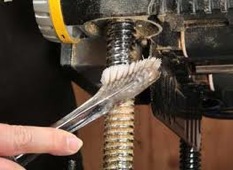
Most tools are designed for specific applications. You cannot have a single tool that will fulfill every purpose. Therefore, most people will have a range of tools in their toolbox. An average person’s toolbox will contain some tools for metalworking and some tools for woodworking, as both activities are often required around the house. Throw in some tools for plumbing and your set is complete. You can further segregate the tools that have a cutting edge.
Taking care of your tools is as important as taking care of yourself. Not only are tools expensive, their utility value makes them more so when you need them most. Imagine your basement flooded because of a burst pipe and you unable to do anything because your pipe-wrench is all rusted up from last season. It is not that taking care of tools takes up much of your time. Cleaning and oiling your tools should form a part of your regular routine of work.
Cleaning and Oiling Your Tools
Dust, rust and moisture are three common enemies for all types of tools. Make it a habit of cleaning dust off your tools after work with a cloth duster or a hand brush. Since dust can get into hinges, joints and screw threads and is difficult to remove, pay special attention to these areas while cleaning. If necessary, clean the tools with a vacuum cleaner working in reverse as a blower. While cleaning, protect your eyes with a pair of safety glasses. While an old toothbrush will do for most general-purpose cleaning, for dust and metal parts lodged in teeth of the tool, use a hard metal brush

Rust is usually associated with high humidity and will corrode and damage most metal permanently. It is important to prevent rust from getting on to your tools and to remove it quickly if it your tool has it. It is best to keep your tools within a toolbox and store the toolbox in a dry place. For extra protection, it helps to add a canister of silica gel or Bull Frog strips of vapor corrosion inhibitors. These remove the moisture from the air near the tools, keeping them dry.
If rust has a foothold, spray the rusted surface lightly with WD-40, a penetrating lubricant and follow-up with a scrub using a heavy-duty scrub-pad such as Scotch-Brite. It is best not to use sandpaper, as it scratches the metal surface. Put away the tool after wiping away the excess lubricant.
Use Rust-Free for cleaning metal that is more heavily rusted. This is a rust remover and is acid-based. Spray it on and after some time, wipe off. Then apply a coat of Boeshield T-9, which is a rust-inhibitor spray. Allow a thin film of the wax-like substance on the metal surface, and you can wipe of any excess immediately.
Working with water pipes, plumbing and taps will invariably leave water on the tools you use. It is important to shake off the excess water, wipe the tools dry and clean off any moisture collected on screw threads and in all nooks and crevices. One option is to leave the tools in the sun for an hour to dry them. Oil them lightly before storage.
Caring For the Cutting Edge
Tools that have cutting edges need some extra care other than routine cleaning and oiling. You must examine their cutting edges periodically to make sure they are sharp and do not have nicks in them. Saws, chisels, knives and drill-bits require regular sharpening to keep them effective. Most of the tools with cutting edges have a specific angle that has to be maintained when you sharpen them. Follow the manufacturer’s instructions for sharpening or get them sharpened by a professional.
Before starting to sharpen its cutting edge, it is very important to hold the tool firmly in a Bench-vise or C-clamp. If the tool moves, you can get the wrong angle on it, damage the sharpening instrument itself, or worse still, cause an injury to your body.
Handle With Care
If you cannot hold a tool properly, you cannot use it properly either. Handles on tools are a necessity that allows you to use the tool effectively. Therefore, it is important to treat the handle of the tool with the same respect you show to the tool itself. Replace the broken handle of a tool immediately or do not use the tool until you have done so.
Wooden handles are prone to dry up and crack. Coating them with boiled linseed oil is a great way to prevent that from happening. In summer, when the moisture content in the air is high, handles feel slippery because palms usually sweat. A spray-on rubber coating, also available as a dip, will prevent the slipping and improve the grip on the tool.
Four-Point Checklist
To start you on the right path for caring for your tools, this small checklist should help:
1. Put away your tools (do not leave them strewn about).
2. Clean and dry your tools.
3. Protect your tools from rusting.
4. Care for the handle as well.
Make it a point to follow the checklist diligently and it will become second nature very soon.